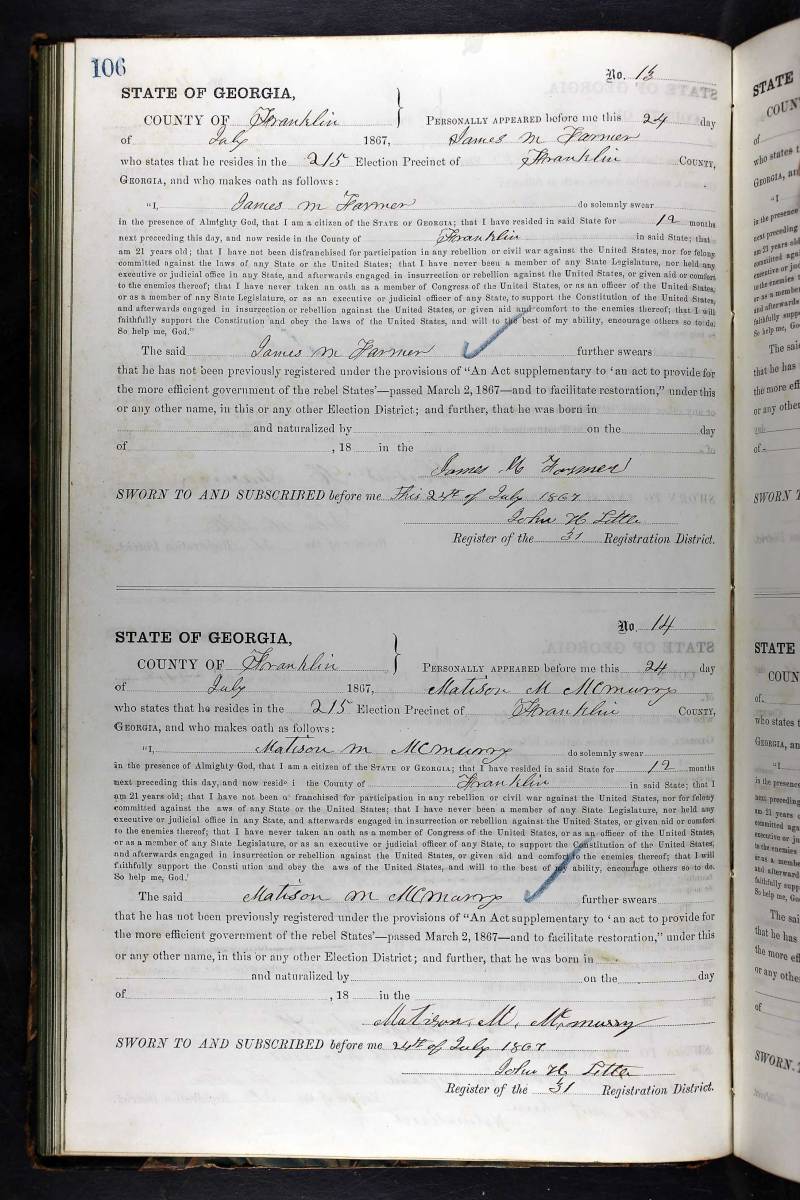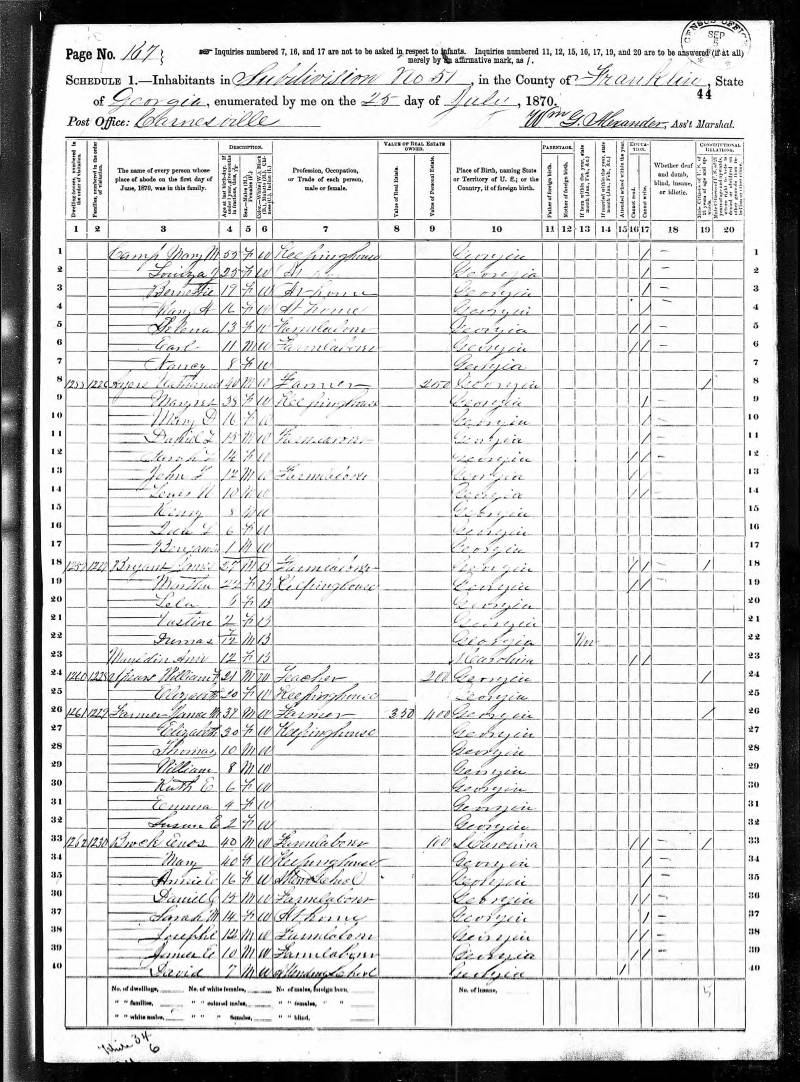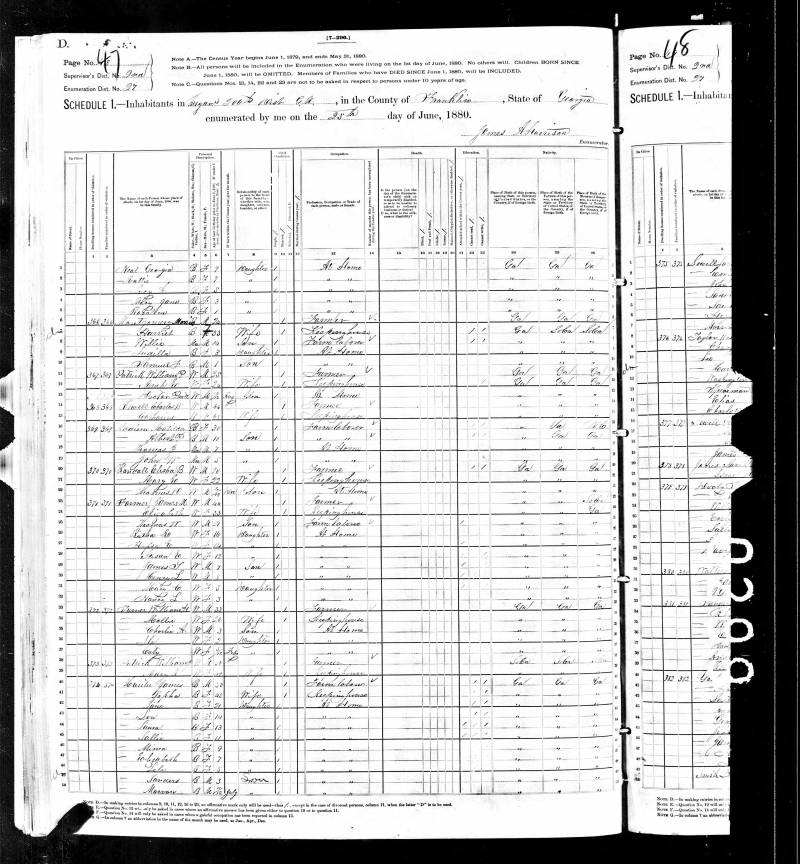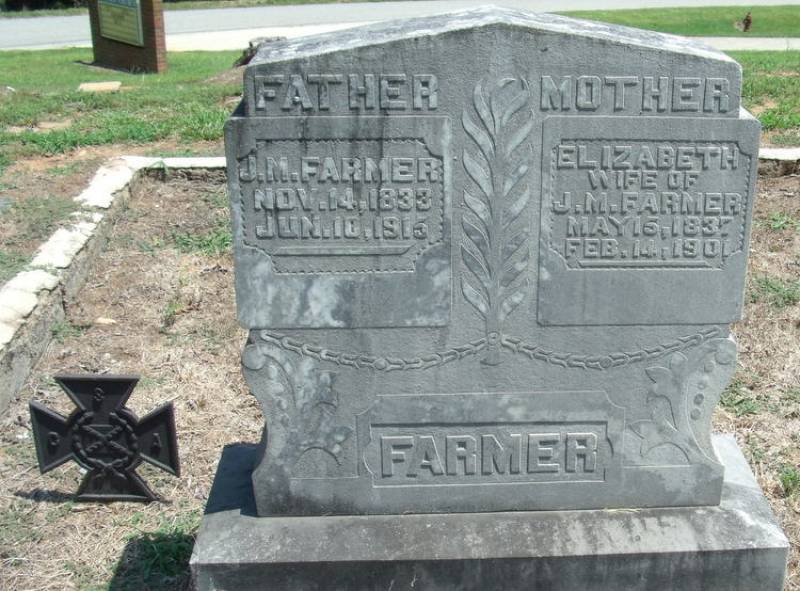Warning: Undefined array key 1 in /webroot/r/r/rrandall001/bull-randall.com/www/lib/plugins/note/syntax.php on line 103
Warning: Undefined array key 1 in /webroot/r/r/rrandall001/bull-randall.com/www/lib/plugins/note/syntax.php on line 103
Warning: Undefined array key 1 in /webroot/r/r/rrandall001/bull-randall.com/www/lib/plugins/note/syntax.php on line 103
Warning: Undefined array key 1 in /webroot/r/r/rrandall001/bull-randall.com/www/lib/plugins/note/syntax.php on line 103
Warning: Undefined array key 1 in /webroot/r/r/rrandall001/bull-randall.com/www/lib/plugins/note/syntax.php on line 103
Table of Contents
James Monroe (Morris) Farmer
Son of Elam Farmer1) and Hepzibah “Hepsie” Harrison2), James “Jim” Monroe Farmer was born on Nov. 14, 1833 in Franklin County, Georgia.3)
Also, James M. Farmer was inconsistent in stating his age and birth year. His tombstone states that he was born in 1833, which is consistent with the age he reported in his 1870 & 1910 U.S. Census. However, in his 1900 U.S. Census he specifically states that his birth month / year was Nov. 1835; which is consistent with the age he reported in his 1860 & 1880 U.S. Census.
On January 15, 1857, James M. Farmer (at age 23) married Elizabeth “Bettie” Harrison, age 19 (May 15, 1837 - Feb. 14, 1901)4) in Franklin County, Georgia.5)
They had the following children:
- Thomas W. Farmer (1860 - April 20, 1946)6)
- William Farmer (1862 - )
- Ruth Ella Farmer (June 24, 1863 - )
- Hepsa Emma Farmer (1866 - )
- Susan Elizabeth Farmer
- James Terrell Farmer (March 5, 1871 - March 20, 1930)7)
- Henry L. Farmer (1872/73 - )
- Mary Catherine Farmer-Aderhold (Aug. 22, 1875 - June 23, 1949)8)
- Nancy Luanna Farmer-Sewell (Aug. 17, 1877 - May 31, 1944)9)
Also, FindAGrave.com lists his birth date as “Oct. 1860”, yet his name appears in the 1860 U.S. Census… which was dated July 26, 1860. These inconsistencies / errors have yet to be resolved.
1860 United States Federal Census
State: Georgia
County: Franklin
Post Office: Carnesville
Date: July 26, 1860
| Name | Age | Gender | Occupation | Birthplace |
|---|---|---|---|---|
| James M. Farmer | 24 | M | Farmer | Georgia |
| Elizabeth Farmer | 21 | F | Georgia | |
| Thomas Farmer | 3 | M | Georgia |
There were multiple issues with the ages of the Farmer family:
Note 1: James M. Farmer was actually 26 instead of 24.
Note 2: Elizabeth Farmer was actually 23 instead of 21.
Note 3: Thomas Farmer was likely 3 months old rather than 3 years old.
Source: Year: 1860; Census Place: Subdivision, Franklin, Georgia; Roll: M653_121; Page: 650; Family History Library Film: 803121
The “War of Northern Aggression”
On January 19, 1861, 293 delegates to the Georgia Secession Convention at the statehouse in Milledgeville, Georgia, met to vote on the “Ordinance of Secession” (to announce Georgia's formal secession from the United States of America). The vote was 208 yeas 89 nays on January 19, 1861 to ratify the “Ordinance of Secession”. The “Ordinance of Secession” was signed on January 21, 1861 and enacted on January 22, 1861.10) This was followed by the “Georgia Declaration of Secession” listing the causes leading to the secession.
The term “War of Northern Aggression” is used here because that is likely what the war was called by our Southern ancestors (or “War for Southern Independence”). While the term “Civil War” was used by Abraham Lincoln during multiple occasions – and the U.S. Supreme Court (The Brig Amy Warwick, et al., 67 U.S. 635, 636, 673 (1862)) during the war, it is entirely incorrect.
A civil war is a war between citizens of the same state contending for control of the same government. The war between the North and South was the war of the North against a separate government, that as long as it lasted was a de facto nation, exercising all the powers of an independent government. The term “civil war” concedes all that the North ever claimed, makes [the South] guilty of treason, and is untrue to the facts in the case. [The] term “civil war,” while incorrect as a simple definition of the struggle, does a gross injustice to the South by degrading her struggle for a national existence into a partisan conflict. I never use it and mark it out of every book where I find it. Let history tell the truth.
Rev. S.A. Steel, Jackson, Tenn.
Source: “The Phrase “Civil War,” Confederate Veteran, July 1912, pg. 347
Officially, the U.S. Congress used the term “The War between the States” in a report to the Senate on joint resolution No. 41, printed in the Congressional Record of March 2, 1928, on page 4061. However, the National Park Service, the government organization entrusted by the United States Congress to preserve the battlefields of the war, uses the term “Civil War”.
The Conscription Act
On April 16, 1862, the Confederacy—in need of troops to fight in its armies—passed the Conscription Act, the first effective general military draft in America.
When the “War of Northern Aggression” began, the Confederacy had set its volunteers’ terms of enlistment for one year. However, as the year mark neared, it became obvious that the war would last for much longer and that the Confederate armies would need more soldiers. So in April 1862, in a secret session of the Confederate Congress, the Conscription Act was passed, which drafted healthy white men ages 18 to 35 for three-year terms (later acts would extend the ages first to 18 to 45, and later to 17 to 50). The Confederate Congress also extended the terms of those already serving under one-year enlistments for another two years (though the soldiers would effectively serve for the duration of the war).
[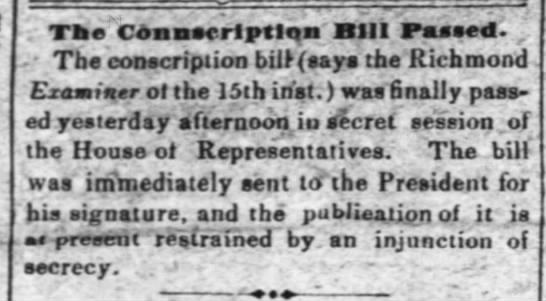 ]
]
The act allowed those drafted to find substitutes to serve in their place (though this would be discontinued in December 1863) and exempted men serving in occupations deemed critical to the war effort or civilian life. In the fall of 1862, exemptions were also extended to those who owned or oversaw 20 or more slaves.
The U.S. Federal government instituted its own draft a year later, in March 1863. The Enrollment Act called on men ages 20 to 45 to register for the draft. As in the South, substitutes were allowed, or else men could pay a $300 commutation fee (though commutation fees were eventually banned in 1864). Like the Confederacy, the U.S. Federal government allowed some exemptions for certain occupations, physical disability, and religious conscientious objectors.
Conscription was partially meant to encourage voluntary enlistment, as those who joined as volunteers were eligible to receive bounty money (enlistment bonuses) from states, counties, cities, and the U.S. federal government—in some cases totaling a sum upwards of $1,000. However, these bounties created the problem of bounty jumping, wherein men would volunteer, collect the money, then desert and re-enlist elsewhere and collect that money as well.
In the Union and Confederacy, conscription was generally a disproportional burden on the poor, since they were unable to pay for a substitute or a commutation fee. But while the draft was hated in both the North and the South, it was only in the North that it sparked riots, the most violent of which killed more than a hundred people—many of them black—in the New York City Draft Riots of July 1863.
Sources:
https://blog.fold3.com/americas-first-military-draft-begins-april-16-1862/
https://www.newspapers.com/clip/4643787/confederate_conscription_bill_passed/
Shortly after passage of “The Conscription Act”, James Morris Farmer (then age 29) volunteered to serve in the Confederate 34th Infantry Regiment, Co. G on May 12, 1862 in Carnsville, GA (Franklin County).11)
This was the same day that Anderson Smith Randal and his Brother-in-law, Elisha (Eli) W. Mitchell (sometimes appearing as Mitchael) joined the same unit.
James Morris Farmer entered with the rank of 2nd Sergeant.
The Georgia 34th Infantry Regiment
[![The 34th Georgia Infantry Regimental Flag. At right is Jerry Bishop, the great-great-grandson of 2nd Sgt. John T. Hasty of the 34th GA, Co. B. Pictured on the left is Morgan Adams, the great-great-great-great-grandson of 2nd Sgt. Hasty. \\ Source: [[http://www.battleofraymond.org/flag.htm|http://www.battleofraymond.org/flag.htm]] The 34th Georgia Infantry Regimental Flag. At right is Jerry Bishop, the great-great-grandson of 2nd Sgt. John T. Hasty of the 34th GA, Co. B. Pictured on the left is Morgan Adams, the great-great-great-great-grandson of 2nd Sgt. Hasty. \\ Source: [[http://www.battleofraymond.org/flag.htm|http://www.battleofraymond.org/flag.htm]]](/lib/exe/fetch.php?media=anderson_smith_randal:confederate_34th_regimental_infantry_flag.jpg) ]
Organized in May, 1862, at Camp McDonald, near Marietta, Georgia, the 34th Infantry Regiment recruited its members in the counties of Bartow, Cherokee, Floyd, Franklin, Polk, Cobb, Paulding, Carroll, Haralson, and Jackson. The unit was sent to Tennessee, then Mississippi where it was assigned to T.H. Taylor's Brigade, Department of Mississippi and East Louisiana. It participated in the battle at Champion's Hill (which the Confederates referred to as “The Battle of Baker's Creek”) and was captured at Vicksburg on July 4, 1863. Exchanged and reorganized, the 34th Infantry Regiment was placed in General Cummings' Brigade, Army of Tennessee. The 34th was active in many engagements from Chattanooga to Nashville, and ended the war in North Carolina. It reported 34 casualties at Chattanooga, contained 369 men and 266 arms in December, 1863, and had 219 fit for duty in January, 1865. Very few surrendered in April. The field commanders were Colonel J.A.W. Johnson, Lieutenant Colonel J.W. Bradley, and Majors Thomas T. Dorough and John M. Jackson.
]
Organized in May, 1862, at Camp McDonald, near Marietta, Georgia, the 34th Infantry Regiment recruited its members in the counties of Bartow, Cherokee, Floyd, Franklin, Polk, Cobb, Paulding, Carroll, Haralson, and Jackson. The unit was sent to Tennessee, then Mississippi where it was assigned to T.H. Taylor's Brigade, Department of Mississippi and East Louisiana. It participated in the battle at Champion's Hill (which the Confederates referred to as “The Battle of Baker's Creek”) and was captured at Vicksburg on July 4, 1863. Exchanged and reorganized, the 34th Infantry Regiment was placed in General Cummings' Brigade, Army of Tennessee. The 34th was active in many engagements from Chattanooga to Nashville, and ended the war in North Carolina. It reported 34 casualties at Chattanooga, contained 369 men and 266 arms in December, 1863, and had 219 fit for duty in January, 1865. Very few surrendered in April. The field commanders were Colonel J.A.W. Johnson, Lieutenant Colonel J.W. Bradley, and Majors Thomas T. Dorough and John M. Jackson.
Muster Roll of Company G, 34th Regiment, Georgia Volunteer Infantry.
Champion Hill (Bakers Creek)
Campaign: Grant's Operations Against Vicksburg
Date(s): March-July 1863
Principal Commanders:
Lieutenant General Ulysses Grant [US]
Lieutenant General John Pemberton [CS]
Following the Union occupation of Jackson, Mississippi, both Confederate and Federal forces made plans for future operations. Gen. Joseph E. Johnston (CSA) retreated, with most of his army, up the Canton Road, but he ordered Lt. Gen. John C. Pemberton (CSA), commanding about 23,000 men, to leave Edwards Station and attack the Federals at Clinton.
Pemberton and his generals felt that Johnston's plan was dangerous and decided instead to attack the Union supply trains moving from Grand Gulf to Raymond. On May 16, though, Pemberton received another order from Johnston repeating his former directions. Pemberton had already started after the supply trains and was on the Raymond-Edwards Road with his rear at the crossroads one-third mile south of the crest of Champion Hill. Thus, when he ordered a countermarch, his rear, including his many supply wagons, became the advance of his force.
On May 16, 1863, about 7:00 am, the Union forces engaged the Confederates and the “Battle of Champion Hill” (Union) / “Bakers Creek” (CSA) began. Pemberton's force drew up into a defensive line along a crest of a ridge overlooking Jackson Creek. Pemberton was unaware that one Union column was moving along the Jackson Road against his unprotected left flank. For protection, Pemberton posted Brig. Gen. Stephen D. Lee's men atop Champion Hill where they could watch for the reported Union column moving to the crossroads. Lee spotted the Union troops and they soon saw him. If this force was not stopped, it would cut the Confederate forces off from their Vicksburg base. Pemberton received warning of the Union movement and sent troops to his left flank. Union forces at the Champion House moved into action and emplaced artillery to begin firing. When Grant arrived at Champion Hill, around 10:00 am, he ordered the attack to begin. By 11:30 am, Union forces had reached the Confederate main line – and about 1:00 pm, they took the crest while the Confederate forces retired in disorder. The Federals advanced, capturing the crossroads and closing the Jackson Road escape route.
One of Pemberton's divisions (Bowen's) then counterattacked, pushing the Federals back beyond the Champion Hill crest before their surge came to a halt. Grant then counter-attacked, committing forces that had just arrived from Clinton by way of Bolton. Pemberton's men could not stand up to this assault, so he ordered his men from the field to the one escape route still open: the Raymond Road crossing of Bakers Creek. CSA Brig. Gen. Lloyd Tilghman's brigade formed the rearguard, and they held at all costs, including the loss of Tilghman. In the late afternoon, Union troops seized the Bakers Creek Bridge, and by midnight, they occupied Edwards. The Confederate forces were forced to retreat towards Vicksburg.
Anderson Smith Randal was among those captured on May 16, 1863 by Union forces. Georgia Casualties At Champion Hill (Baker’s Creek).pdf
Results: Union Victory / Confederate Defeat
Estimated Casualties: 6,281 total (US 2,441; CS 3,840)
Vicksburg
Campaign: Grant's Operations Against Vicksburg (Union)
Date(s): March-July 1863
Principal Commanders:
Lieutenant General Ulysses Grant [US]
Lieutenant General John Pemberton [CS]
In May and June of 1863, Maj. Gen. Ulysses S. Grant's armies converged on Vicksburg, investing the city and entrapping a Confederate army under Lt. Gen. John Pemberton. On July 4, Vicksburg surrendered after prolonged siege operations. With the loss of Pemberton's army and this vital stronghold on the Mississippi, the Confederacy was effectively split in half. Grant's successes in the West boosted his reputation, leading ultimately to his appointment as General-in-Chief of the Union armies.
Results: Union Victory / Significant Confederate Defeat
Estimated Casualties: 37,532 total (US 4,835; CS 32,697)
Farmer, James Monroe - 2nd Sergeant May 12, 1862.
In General Hospital Dalton, Ga from July 30 to Aug. 7 1862 for Febris remittens.
Captured at surrender of Vicksburg July 4, 1863. Paroled July 8, 1863.
Source: http://www.ranger95.com/civil_war/georgia/infantry/34inf_rgt/34th_inf_regt_rost_g.html
Some additional information is available in the “Compiled Service Records of the 34th regiment”.
Chattanooga II
Campaign: Chickamauga Campaign (Union)
Date(s): August-September 1863
Principal Commanders:
Colonel John Wilder [US]
Colonel Daniel Hill [CS]
On August 16, 1863, Maj. Gen. William S. Rosecrans, commander of the Army of the Cumberland (Union), launched a campaign to take Chattanooga. Col. John T. Wilder's brigade of the Union 4th Division, XIV Army Corps marched to a location northeast of Chattanooga where the Confederates could see them, reinforcing Gen. Braxton Bragg's expectations of a Union attack on the town from that direction.
On August 21, Wilder reached the Tennessee River opposite Chattanooga and ordered the 18th Indiana Light Artillery to begin shelling the town. The shells caught many soldiers and civilians in town in church observing a day of prayer and fasting. The bombardment sank two steamers docked at the landing and created a great deal of consternation amongst the Confederates. Continued periodically over the next two weeks, the shelling helped keep Bragg's attention to the northeast while the bulk of Rosecrans's Union army crossed the Tennessee River well west and south of Chattanooga. When Bragg learned on September 8 that the Union army was in force southwest of the city, he abandoned Chattanooga.
Results: Union Victory
Nashville
Campaign: Savannah Campaign
Date(s): September-December 1864
Principal Commanders:
Major General George Thomas [US]
General John Hood [CS]
In a last desperate attempt to force Maj. Gen. William T. Sherman's army out of Georgia, Gen. John Bell Hood (CSA) led the Army of Tennessee north toward Nashville in November 1864. Although he suffered terrible losses at Franklin on November 30, he continued toward Nashville. By the next day, the various elements of Maj. Gen. George H. Thomas's army (Union) had reached Nashville. Hood reached the outskirts of Nashville on December 2, occupied positions on a line of hills parallel to those of the Union and began erecting fieldworks.
Union Army Engineer, Brig. Gen. James St. Clair Morton, had overseen the construction of sophisticated fortifications at Nashville in 1862-63, strengthened by others, which would soon see use. From the 1st through the 14th, Thomas (Union) made preparations for the Battle of Nashville in which he intended to destroy Hood's army. On the night of December 14, Thomas informed Maj. Gen. Henry W. Halleck, acting as Maj. Gen. Ulysses S. Grant's chief of staff, that he would attack the next day. Thomas planned to strike both of Hood's flanks.
Before daylight on the 15th, the first of the Union troops, led by Maj. Gen. James Steedman, set out to hit the Confederate right. The attack was made and the Union forces held down one Confederate corps there for the rest of the day. Attack on the Confederate left did not begin until after noon when a charge commenced on Montgomery Hill. With this charge's success, attacks on other parts of the Confederate left commenced, all eventually successful. By this time it was dark and fighting stopped for the day. Although battered and with a much smaller battle line, Gen. Hood (CSA) was still confident. He established a main line of resistance along the base of a ridge about two miles south of the former location, throwing up new works and fortifying Shy's and Overton's hills on their flanks. The IV Army Corps (Union) marched out to within 250 yards, in some places, of the Confederate's new line and began constructing fieldworks. During the rest of the morning, other Union troops moved out toward the new Confederate line and took up positions opposite it. The Union attack began against Hood's strong right flank on Overton's Hill. The same brigade that had taken Montgomery Hill the day before received the nod for the charge up Overton's Hill. This charge failed, but other troops (Maj. Gen. A.J. Smith's “Israelites”) successfully assaulted Shy's Hill in their fronts. Seeing the success along the line, other Union troops charged up Overton's Hill and took it. Hood's army retreated, but the Union army pursued. For ten days, the pursuit continued until the beaten and battered Army of Tennessee recrossed the Tennessee River. Hood's army was stalled at Columbia, beaten at Franklin, and routed at Nashville. Hood retreated to Tupelo and resigned his command.
Results: Union Victory
Estimated Casualties: 9,561 total (US 3,061; CS 6,500)
MUSTER ROLL OF *COMPANY G, 34th REGIMENT
GEORGIA VOLUNTEER INFANTRY
ARMY OF TENNESSEE
C. S. A.
FRANKLIN COUNTY, GEORGIA
*This company was also known as Co. C.
Farmer, James M. 2d Sergeant May 12, 1862.
Captured at Vicksburg, Miss. July 4,1863, and paroled there July 8, 1863.
Pension records show he was wounded at Nashville, Tenn. December 16, 1864, and was at home, wounded, close of war.
Source: http://files.usgwarchives.net/ga/franklin/military/civilwar/rosters/cog34reg.txt
The Army of Tennessee Surrenders
Following the strategic defeat the Army of Tennessee had suffered at Bentonville, North Carolina, 21 March, 1865 the army retired before Major General William T. Sherman's forces, about twice their numbers. At Goldsborough on 24 March, 1865 the Federal army swelled to 80,000 men when Major General John M. Schofield's force joined with that of Sherman. When Sherman resumed his march northwards on 10 April, 1865 Johnston followed him having no illusions about being able to stop him on his march through North Carolina. While en route Johnston learned of the evacuation of Petersburg and Richmond, Virginia, and of the Army of Northern Virginia's surrender at Appomattox, Virginia. This brought to an end the hope of joining the two Confederate armies together to defeat first one then the other of their opponents.
Upon arriving near Raleigh, North Carolina, Johnston first attempted to have North Carolina Governor Zebulon Baird Vance broach surrender terms to Sherman. A task that he refused. On 12 April he went to Greensborough to meet with Confederate States President Jefferson Finis Davis from whom he obtained permission to open a peace initiative. Sherman was immediately receptive to peace negotiations and so on 17 April, 1865 he met with Johnston near Durham Station, North Carolina. During the two day conference, at the home of James Bennett, terms were agreed that were acceptable to both Generals. But after submitting them to Washington for approval they were quickly rejected.
Johnston was informed that unless more widely acceptable terms were reached a four day Armistice would end on 26 April 1865. So once again the two army Commanders met at the James Bennett home and thrashed out an agreement that gave the same terms that the Army of Northern Virginia had accepted. This was acceptable to the Washington government and on 3 May, 1865 the Army of Tennessee, with 29,924 troops, laid down its arms.
This included the Confederate 34th Infantry Regiment, Co. G, in Anderson, S.C., of which Anderson Smith Randal was attached.
by Ron Perrin, Fort Worth, Texas
“The Real Story is much more interesting and has gone untold in fear that feelings would be hurt. It's a story of war, the most brutal and bloody war, military might and power pushed upon civilians, women, children, and (the) elderly. Never seen as a war crime, this was the policy of the greatest nation on earth trying to maintain that status at all costs. An unhealed wound remains in the hearts of some people of the Southern states today; on the other hand, the policy of slavery has been an open wound that has also been slow to heal but is okay to talk about. The story of THE BLACK EYED PEA being considered good luck relates directly back to Sherman's Blood March to the Sea in late 1864. It was called the Savannah Campaign and was led by Major General William T. Sherman. The Civil War campaign began on 11/15/1864 when Sherman's troops marched from the captured city of Atlanta, Georgia, and ended at the port of Savannah on 12/22/1864.
“When the smoke cleared, the southerners who had survived the onslaught came out of hiding. They found that the blue belly aggressors had looted and stolen everything of value and everything you could eat, including all livestock; death and destruction were everywhere. While in hiding, few had enough to eat, and starvation was now upon the survivors. There was no international aid, no Red Cross meal trucks. The Northern army had taken everything they could carry, and eaten everything they could eat. But they couldn't take it all. The devastated people of the South found for some unknown reason that Sherman's bloodthirsty troops had left silos full of black eyed peas. At the time in the North, the lowly black eyed pea was only used to feed stock. The northern troops saw it as the thing of least value. Taking grain for their horses and livestock and other crops to feed themselves, they just couldn't take everything. So they left the black eyed peas in great quantities assuming it would be of no use to the survivors, since all the livestock it could feed had either been taken or eaten.
“Southerners awoke to face a new year in this devastation and were facing massive starvation if not for the good luck of having the black eyed peas to eat. From New Year's Day 1866 forward, the tradition grew to eat black eyed peas on New Year's Day for good luck.”
After the War
Under the Reconstruction Act of 1867, Confederate veterans were required to take an oath of allegiance to the United States of America.
1870 United States Federal Census
State: Georgia
County: Franklin
Post Office: Carnesville
Date: July 25, 1870
| Name | Age | Gender | Occupation | Birthplace |
|---|---|---|---|---|
| James M. Farmer | 37 | M | Farmer | Georgia |
| Elizabeth Farmer | 30 | F | Domestic | Georgia |
| Thomas Farmer | 10 | M | Georgia | |
| William Farmer | 8 | M | Georgia | |
| Ruth E. Farmer | 6 | F | Georgia | |
| Emma Farmer | 4 | F | Georgia | |
| Susan E. Farmer | 2 | F | Georgia |
Note: Elizabeth Farmer's age was actually 33. Not 30.
Source: Year: 1870; Census Place: Subdivision 51, Franklin, Georgia; Roll: M593_150; Page: 44A; Image: 218736; Family History Library Film: 545649
1880 United States Federal Census
State: Georgia
County: Franklin
Inhabitants of: Bryant (206th Dist.)
Date: June 25, 1880
| Name | Age | Gender | Relationship | Occupation | Birthplace | Birthplace of Father | Birthplace of Mother |
|---|---|---|---|---|---|---|---|
| James M. Farmer | 44 | M | Head | Farmer | Georgia | Georgia | South Carolina |
| Elizabeth Farmer | 33 | F | Wife | Keeping House | Georgia | Georgia | Georgia |
| Thomas W. Farmer | 21 | M | Son | Farm Laborer | Georgia | Georgia | Georgia |
| Rutha E. Farmer | 16 | F | Daughter | At Home | Georgia | Georgia | Georgia |
| Hepsa E. Farmer | 14 | F | Daughter | At Home | Georgia | Georgia | Georgia |
| Susan E. Farmer | 12 | F | Daughter | At Home | Georgia | Georgia | Georgia |
| James T. Farmer | 9 | M | Son | At Home | Georgia | Georgia | Georgia |
| Henry L. Farmer | 8 | M | Son | At Home | Georgia | Georgia | Georgia |
| Mary C. Farmer | 5 | F | Daughter | At Home | Georgia | Georgia | Georgia |
| Nancy L. Farmer | 3 | F | Daughter | At Home | Georgia | Georgia | Georgia |
Note 1: James M. Farmer's age was actually 46. Not 44.
Note 2: Elizabeth Farmer's age was actually 43. Not 33.
Source: Year: 1880; Census Place: District 206, Franklin, Georgia; Roll: 147; Family History Film: 1254147; Page: 520D; Enumeration District: 027; Image: 0324
As indicated by the U.S. Census, during 1880, James M. Farmer's family lived next door to a son of Anderson Smith Randal, Elisha Burrell Randall. Seven years later, his brother, Thomas Watson Randall, would marry James M. Farmer's daughter, Rutha Ella Farmer.
1900 United States Federal Census
State: Georgia
County: Franklin
Township or Other Division of County: Bryant District
Date: June 13, 1900
| Name | Relationship | Gender | Date of Birth | Age | Birthplace | Birthplace of Father | Birthplace of Mother | Occupation |
|---|---|---|---|---|---|---|---|---|
| James Farmer | Head | M | Nov. 1835 | 64 | Georgia | Georgia | Georgia | Farmer |
| Elizabeth Farmer | Wife | F | May 1839 | 61 | Georgia | Georgia | Georgia | None |
| Emma Farmer | Daughter | F | Mar. 1866 | 34 | Georgia | Georgia | Georgia | None |
| Elizabeth Farmer | Daughter | F | Oct. 1868 | 31 | Georgia | Georgia | Georgia | None |
Note 1: According to the tombstone of Robert Thomas Randall (appearing in the census as Thomas R. Randall), he was actually born in 1888… not 1890 (as the 1900 U.S. Census indicates).
Note 2: Napoleon Randall's tombstone, his birth year was actually 1893, not 1894.
Note 3: Although incorrectly identified as his “mother”, from the Census we see that John W. Randall's Mother-in-law (Nancy E. Mitchell Thomas) was living with them in 1900… the year before her death. We also learn that Nancy Thomas could not read or write.
Source: Year: 1900; Census Place: Bryant, Franklin, Georgia; Roll: 197; Page: 13A; Enumeration District: 0022; FHL microfilm: 1240197
1910 United States Federal Census
State: Georgia
County: Franklin
Township or other Division of County: (206) Bryant's District
Date: April 21-22, 1910
| Name | Relation | Gender | Age | Marital Status | Birthplace | Birthplace of Father | Birthplace of Mother | Occupation |
|---|---|---|---|---|---|---|---|---|
| James M. Farmer | Head | M | 77 | Widower | Georgia | Georgia | Georgia | Farmer |
| Emma Farmer | Daughter | F | 44 | Single | Georgia | Georgia | Georgia | None |
| Lizzie Farmer | Daughter | F | 39 | Single | Georgia | Georgia | Georgia | None |
| H.B. Randall | Grandson | M | 19 | Single | Georgia | Georgia | Georgia | None |
Note 1: “Emma” was his daughter, Hepsa Emma Farmer.
Note 2: “Lizzie” was his daughter, Susan Elizabeth Farmer. And she was actually 42 years old, not 39.
Note 3: “H.B. Randall” was James M. Randall's grandson, Henry Beaman Randall.
Source: Year: 1910; Census Place: Bryant, Franklin, Georgia; Roll: T624_189; Page: 5B; Enumeration District: 0036; FHL microfilm: 1374202
James M. Farmer died on June 10, 1915. He was buried at “Clarks Creek Baptist Church Cemetery” in Martin (Franklin County), Georgia.12)

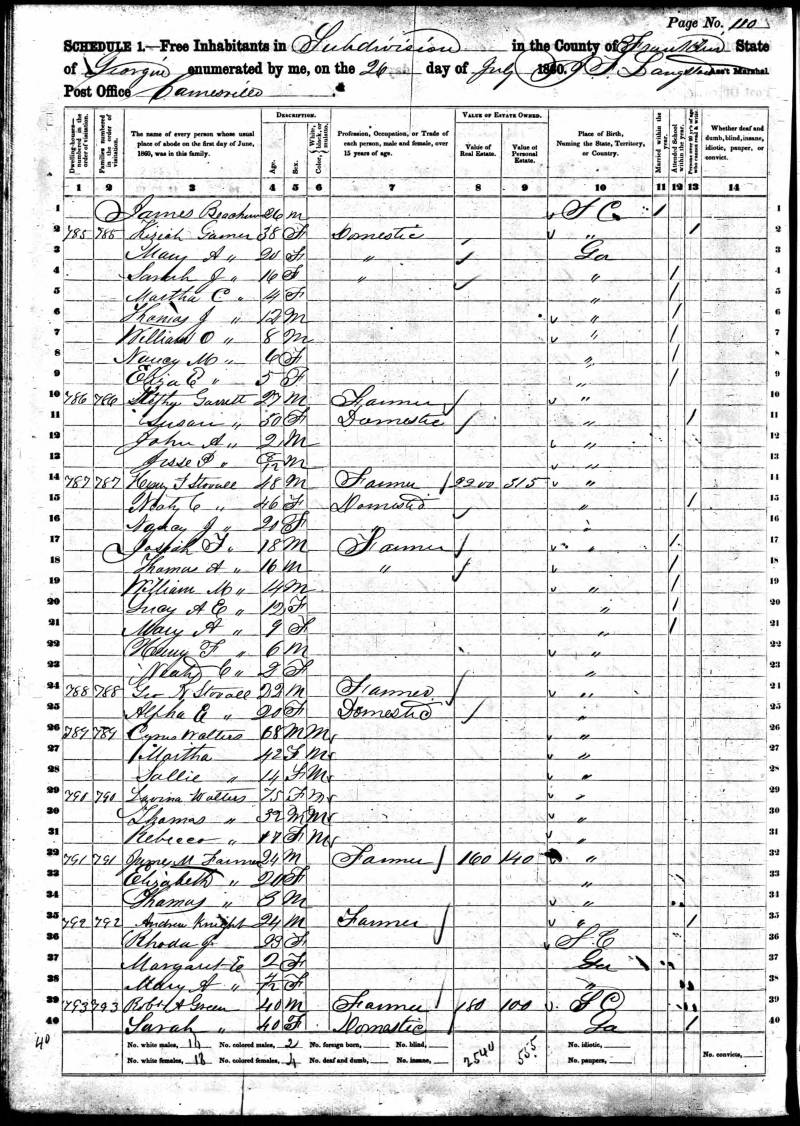
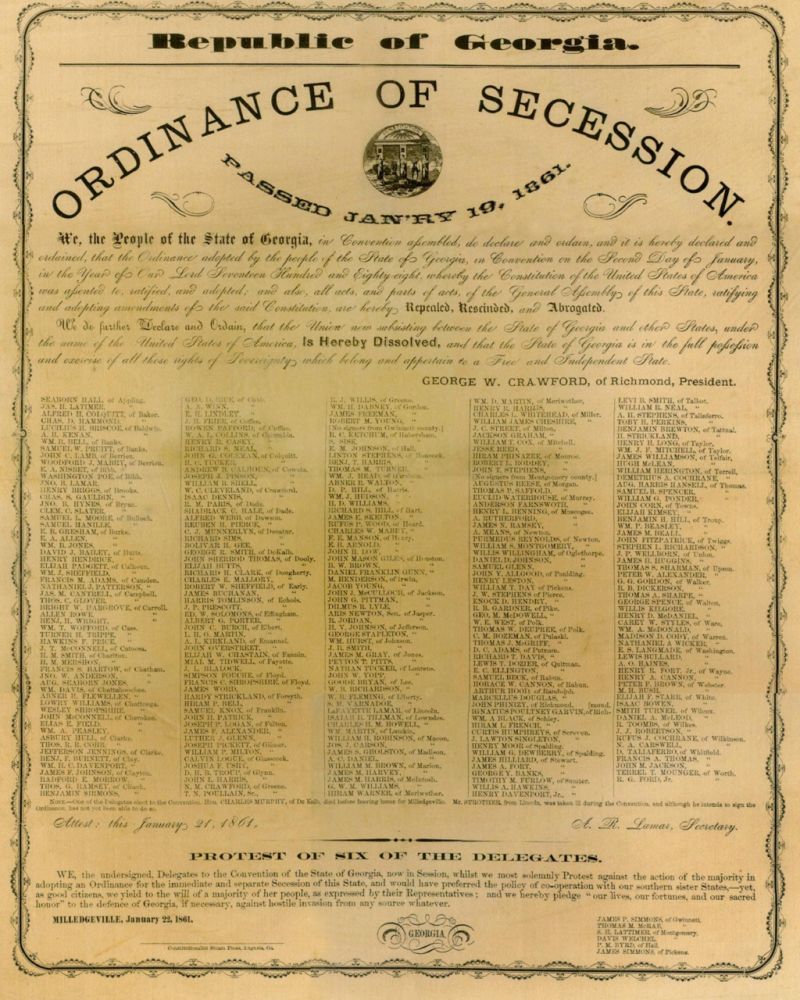
![The 34th GA flag is seventy-two and one-half inches by 33 inches. There are three strips of white silk. Each strip is 11 inches wide. They are hand stitched together. The twenty-two inch canton has in the center one gold star with a red dot; above and below the star are two gloves, one pointing up and one pointing down. Each has a gold heart embroidered on the back of it. There are ten other gold stars with red dots in the center. A green wreath and red flowers circle the ten stars. It is patterned exactly after the original. \\ Source: [[http://www.battleofraymond.org/flag.htm|http://www.battleofraymond.org/flag.htm]] The 34th GA flag is seventy-two and one-half inches by 33 inches. There are three strips of white silk. Each strip is 11 inches wide. They are hand stitched together. The twenty-two inch canton has in the center one gold star with a red dot; above and below the star are two gloves, one pointing up and one pointing down. Each has a gold heart embroidered on the back of it. There are ten other gold stars with red dots in the center. A green wreath and red flowers circle the ten stars. It is patterned exactly after the original. \\ Source: [[http://www.battleofraymond.org/flag.htm|http://www.battleofraymond.org/flag.htm]]](/lib/exe/fetch.php?media=anderson_smith_randal:confederate_34th_regimental_infantry_flag2.jpg)
